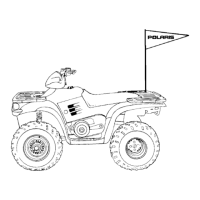ELECTRICAL
5.5
BATTERY INSPECTION/
REMOV
AL
NOTE: PolarisYouthATVsuseamaintenance free
battery. Do not remove the battery cap strip to check
the acid level. Perform the proper battery tests and
replace the battery as needed.
The battery is located under the seat.
Rubber Strap
Battery
1. Remove the rubber strap.
2. Disconnect battery negative (-) (black) cable first,
followed by the positive (+) (red) cable.
CAUTION
Whenever removing or reinstalling the battery,
disconnect the negative (black) cable first and
reinstall the negative cable last.
BATTERY INSTALLATION
1. Cleanbatterycablesand terminals with astiff wire
brush. Corrosion can be removed using a
solution of one cup water mixed with one
tablespoon baking soda. Rinse will with clean
water and dry thoroughly.
2. Reinstallbattery,attachingpositive (+) (red) cable
first and then the negative (-) (black) cable. Coat
terminals and bolt threads with Polaris dielectric
grease (PN 2871027).
3. Route cables so they are tucked away in the
battery compartment.
4. Reinstall the rubber strap.
!
Do not start the engine with the battery
disconnected. Vehicle lamps will burn out if battery is
disconnected during vehicle operation.
BATTERY TESTING
Whenever a service complaint is related to either the
starting or charging systems, the battery should be
checked first.
Following are two tests which can easily be made on
a battery to determine its condition: OCV Test and
Load Test.
OCV - OPEN CIRCUIT
VOLTAGE
TEST
Battery voltage should be checked with a digital
multitester. Readings of 12.5 or less require further
battery testing and charging. See open circuit voltage
chart and Load Test.
NOTE: Batteries should be kept at or near a full
charge as possible. If the battery is stored or used in
apartially charged condition, crystalsulfation will form
on the plates, reducing the efficiency and service life
of the battery.
OPEN CIRCUIT VOLTAGE
State of
charge
Maintenence Free
Batteries
100% Charged
75% Charged
50% Charged
25% Charged
0% Charged
12.8--13.0V
12.5--12.8V
12.0--12.5V
11.5--12.0V
less than 11.50V
LOAD TEST
CAUTION: Remove the spark plug high tension lead
and connect securely to engine ground before
proceeding.
NOTE: This test cannot be performed with an engine
or starting system which is not working properly.
A battery may indicate a full charge condition in the OCV
test and the specific gravity test, but still may not have
the storage capacity necessary to properly function in
the electrical system. For this reason, a battery capacity
or load test should be conducted whenever poor battery
performance is suspected. To perform this test, hook a
multitester to the battery in the same manner as was
done in the OCV test. The reading should be 12.6 volts
or greater. Engage the electric starter and view the
registered battery voltage while cranking the engine.
Continue the test for 15 seconds. During this cranking
period, the observed voltage should not drop below 9.5
volts. If the beginning voltage is 12.6 or higher and the
cranking voltage drops below 9.5 volts during the test,
replace the battery.
Enfocus Software - Customer Support

